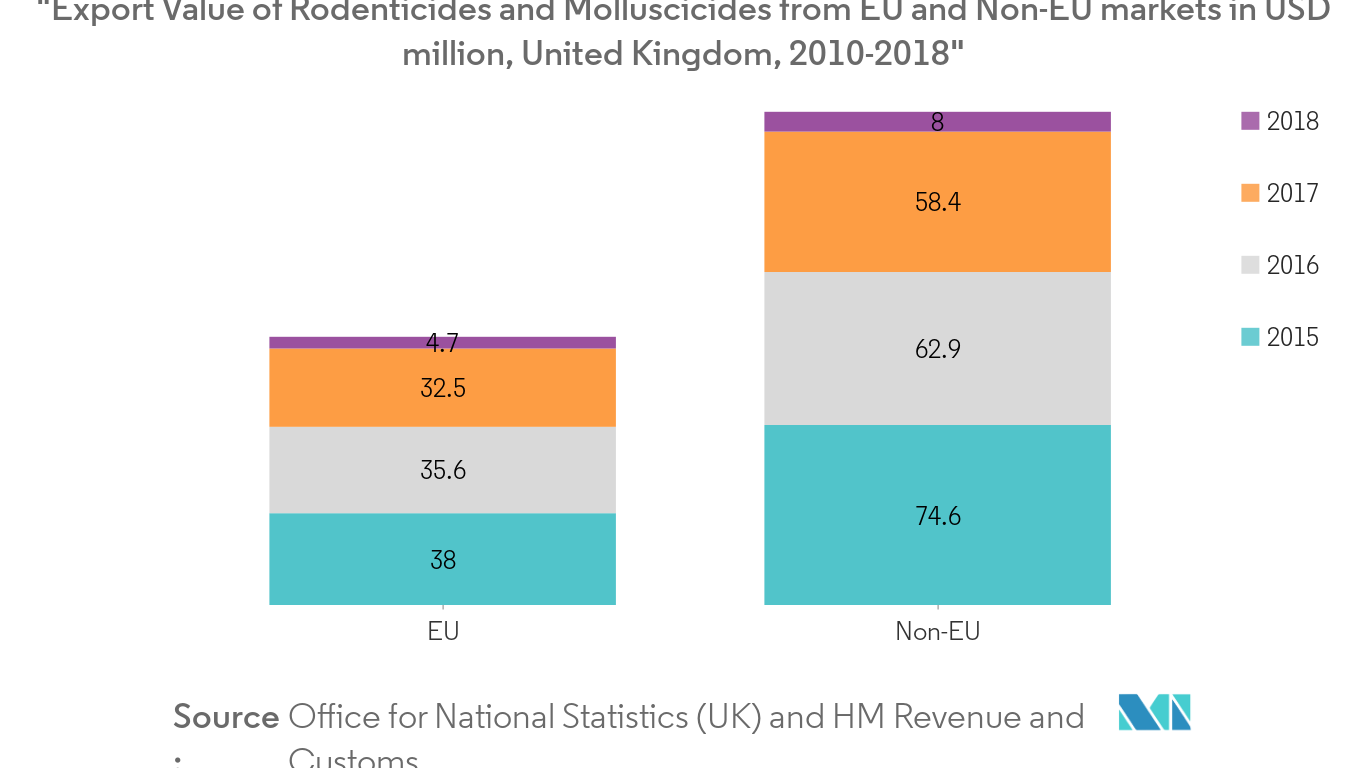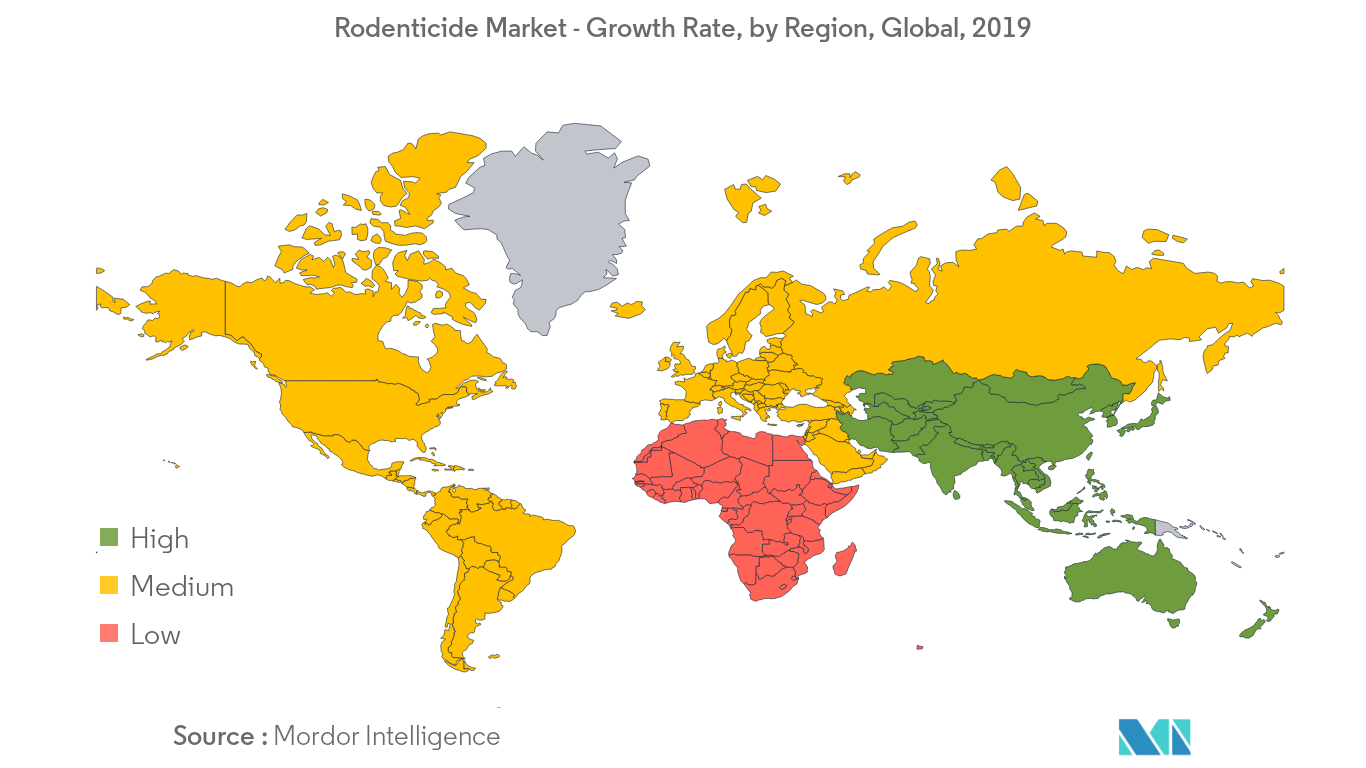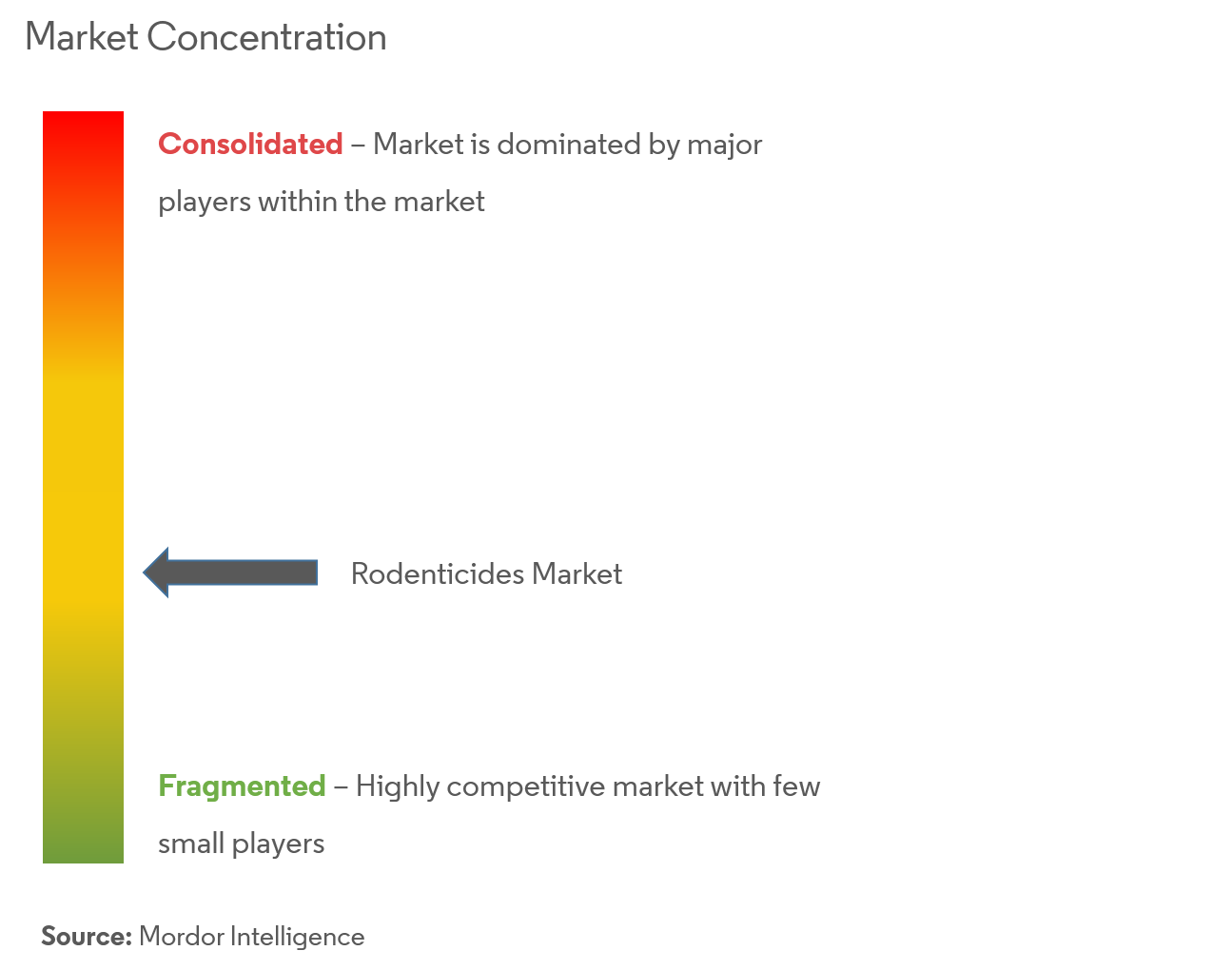Rodenticides Market Size

| Study Period | 2019 - 2029 |
| Market Size (2024) | USD 2.18 Billion |
| Market Size (2029) | USD 2.60 Billion |
| CAGR (2024 - 2029) | 3.50 % |
| Fastest Growing Market | Asia Pacific |
| Largest Market | Europe |
Major Players*Disclaimer: Major Players sorted in no particular order |
Rodenticides Market Analysis
The Rodenticides Market size is estimated at USD 2.18 billion in 2024, and is expected to reach USD 2.60 billion by 2029, growing at a CAGR of 3.5% during the forecast period (2024-2029).
- Asia-Pacific led the market in terms of rate of growth in 2019, owing to a higher demand for rodenticides witnessed in countries such as India and Japan, resulting from rat infestations inagricultural fields,warehouses, and markets.
- However, rigid regulations against the use of second-generation anticoagulant rodenticides in developed countries and regions such as the United States and Europe, are expected to restrain the growth of the overall market.
- The market for rodenticides is fragmented with both international players and regional companies vying for a higher market share in the industry. Some of the major players in the market areBASF SE, Bayer AG, Syngenta, Liphatech Inc., PelGar International,JT Eaton, Neogen Corporation, and Rentokil Initial plc,among others.
Rodenticides Market Trends
This section covers the major market trends shaping the Rodenticides Market according to our research experts:
Stringent Regulations and Government Ban Restraining the Market
Several stringent regulations and subsequent recommendations for a ban on rodenticides have impacted the overall market in recent years. Empirical studies have proven that anticoagulants are the leading cause of deaths of birds of prey and other scavenger species when they eat their poisoned carcasses. Moreover, humans are also posed with intoxication risks due to rodenticide exposure. The United States Environment Protection Agency (EPA) restricted the sale of the second-generation long-acting anticoagulant (LAA) rodenticides such as Brodifacoum and Bromadiolone, in 2013. The AB 1788 Bill was also supposed to ban the second-generation anticoagulant rodenticides (SGARs) in California on account of non-target wildlife poisoning but was pulled away from the Senate Appropriations Committee in August 2019. Moreover, the Biocidal Products Regulation (BPR) of the European Union affects most rodenticides across the region which has further given rise to the Rodenticides Stewardship Regime to be followed by the rodenticide companies and pest controllers. According to the Office for National Statistics (UK) and HM Revenue and Customs, the total export value of rodenticides and molluscicides from EU and non-EU markets in the United Kingdom fell significantly from USD 43.6 million in 2013 to USD 4.7 million in 2018. As such, these factors are expected to affect the demand-supply ratio and prices of rodenticides for agricultural purposes, thus, restraining the growth of the market, during the forecast period.

Asia-Pacific - The Fastest Growing Market
Asia-Pacific registered the fastest growth in the rodenticide market, globally. The frequency of rodent attacks on agricultural fields has been immense in developing countries across the region. According to the International Rice Research Institute (IRRI), rats and mice are estimated to damage 3%-5% of the total cereal crops in developing countries. In 2015, entomologists revealed that up to 54% of the paddy crops were being lost due to rat infestation in Chellampatti and its neighboring areas in Tamil Nadu, one of the largest rice-producing states in India. Moreover, according to a report by the Indian Ministry of Consumer Affairs, about 57,676 metric tons of foodgrains stored in Food Corporation of India (FCI) godowns were damaged due to pest and rodent attacks, leakage of godowns, and exposure to rain and floods, among other reasons. In 2018, Tokyo's Tsukiji fish market with 480 kinds of seafood and 270 types of fruit and vegetable businesses closed down and relocated due to massive rat infestation. As such, the demand for rodenticides in the region is expected to grow during the forecast period.

Rodenticides Industry Overview
The market for global rodenticides is fragmented with the presence of a few international players and numerous emerging players competing to gain a fair share in the rodenticides market, globally. Some of the most active players are BASF SE, Bayer AG, Syngenta, Liphatech Inc., PelGar International, JT Eaton, Neogen Corporation, and Rentokil Initial plc, among others. These companies are targeting countries for business expansion, either by introducing a new product range upon researching, developing and field-testing the product or by acquiring a production unit. For instance, in 2018, BASF launched Selontra rodent bait that provides an efficient and effective rodent control solution through its patented formulation using the active ingredient 'cholecalciferol'.
Rodenticides Market Leaders
-
BASF SE
-
Bayer AG
-
Syngenta
-
Liphatech, Inc.
-
PelGar International
*Disclaimer: Major Players sorted in no particular order

Rodenticides Market Report - Table of Contents
1. INTRODUCTION
- 1.1 Study Deliverables
- 1.2 Study Assumptions
- 1.3 Scope of the Study
2. RESEARCH METHODOLOGY
3. EXECUTIVE SUMMARY
4. MARKET DYNAMICS
- 4.1 Market Overview
- 4.2 Introduction to Market Drivers and Restraints
- 4.3 Market Drivers
- 4.4 Market Restraints
-
4.5 Industry Attractiveness - Porter's Five Force Analysis
- 4.5.1 Threat of New Entrants
- 4.5.2 Bargaining Power of Buyers/Consumers
- 4.5.3 Bargaining Power of Suppliers
- 4.5.4 Threat of Substitute Products
- 4.5.5 Intensity of Competitive Rivalry
5. MARKET SEGMENTATION
-
5.1 Type
- 5.1.1 Non-Anticoagulant Rodenticides
- 5.1.1.1 Bromethalin
- 5.1.1.2 Cholecalciferol
- 5.1.1.3 Zinc phosphide
- 5.1.1.4 Strychnine
- 5.1.2 Anticoagulant Rodenticides
- 5.1.2.1 First-Generation Anticoagulants
- 5.1.2.1.1 Warfarin
- 5.1.2.1.2 Chlorophacinone
- 5.1.2.1.3 Diphacinone
- 5.1.2.1.4 Coumatetralyl
- 5.1.2.2 Second-Generation Anticoagulants
- 5.1.2.2.1 Difenacoum
- 5.1.2.2.2 Brodifacoum
- 5.1.2.2.3 Flocoumafen
- 5.1.2.2.4 Bromadiolone
-
5.2 Form
- 5.2.1 Blocks
- 5.2.2 Pellets
- 5.2.3 Powders
- 5.2.4 Other Modes of Application
-
5.3 Application
- 5.3.1 Agricultural Fields
- 5.3.2 Warehouses
-
5.4 Geography
- 5.4.1 North America
- 5.4.1.1 US
- 5.4.1.2 Canada
- 5.4.1.3 Mexico
- 5.4.1.4 Rest of North America
- 5.4.2 Europe
- 5.4.2.1 Germany
- 5.4.2.2 UK
- 5.4.2.3 France
- 5.4.2.4 Russia
- 5.4.2.5 Spain
- 5.4.2.6 Rest of Europe
- 5.4.3 Asia Pacific
- 5.4.3.1 China
- 5.4.3.2 Japan
- 5.4.3.3 India
- 5.4.3.4 Australia
- 5.4.3.5 Rest of Asia-Pacific
- 5.4.4 South America
- 5.4.4.1 Brazil
- 5.4.4.2 Argentina
- 5.4.4.3 Rest of South America
- 5.4.5 Africa
- 5.4.5.1 South Africa
- 5.4.5.2 Rest of Africa
6. COMPETITIVE LANDSCAPE
- 6.1 Most Adopted Strategies
- 6.2 Market Share Analysis
-
6.3 Company Profiles
- 6.3.1 BASF SE
- 6.3.2 Bayer AG
- 6.3.3 Syngenta
- 6.3.4 Liphatech, Inc.
- 6.3.5 PelGar International
- 6.3.6 JT Eaton
- 6.3.7 Neogen Corporation
- 6.3.8 Rentokil Initial plc
- 6.3.9 SenesTech, Inc.
- 6.3.10 Anticimex
- 6.3.11 Bell Labs
- 6.3.12 Terralink Horticulture Inc.
- *List Not Exhaustive
7. MARKET OPPORTUNITIES AND FUTURE TRENDS
** Subject To AvailablityRodenticides Industry Segmentation
Rodenticides are pesticides that are often formulated with substances such as peanut butter or molasses to attract and kill the rodents present in agricultural fields and warehouses. However, the high level of toxicity for humans has resulted in the ban of several non-anticoagulants and second-generation anticoagulants across the world. The scope of the report includes an all-encompassing analysis of market segmentation based on the types, sub-types, and sub-type divisions of rodenticides. The scope also extends to the segmentation of the market by modes of application and end-use. The report is also constituted of a segmental analysis based on geography covering over 16 countries across the world.
| Type | Non-Anticoagulant Rodenticides | Bromethalin | |
| Cholecalciferol | |||
| Zinc phosphide | |||
| Strychnine | |||
| Type | Anticoagulant Rodenticides | First-Generation Anticoagulants | Warfarin |
| Chlorophacinone | |||
| Diphacinone | |||
| Coumatetralyl | |||
| Type | Anticoagulant Rodenticides | Second-Generation Anticoagulants | Difenacoum |
| Brodifacoum | |||
| Flocoumafen | |||
| Bromadiolone | |||
| Form | Blocks | ||
| Pellets | |||
| Powders | |||
| Other Modes of Application | |||
| Application | Agricultural Fields | ||
| Warehouses | |||
| Geography | North America | US | |
| Canada | |||
| Mexico | |||
| Rest of North America | |||
| Geography | Europe | Germany | |
| UK | |||
| France | |||
| Russia | |||
| Spain | |||
| Rest of Europe | |||
| Geography | Asia Pacific | China | |
| Japan | |||
| India | |||
| Australia | |||
| Rest of Asia-Pacific | |||
| Geography | South America | Brazil | |
| Argentina | |||
| Rest of South America | |||
| Geography | Africa | South Africa | |
| Rest of Africa |
Rodenticides Market Research FAQs
How big is the Rodenticides Market?
The Rodenticides Market size is expected to reach USD 2.18 billion in 2024 and grow at a CAGR of 3.5% to reach USD 2.60 billion by 2029.
What is the current Rodenticides Market size?
In 2024, the Rodenticides Market size is expected to reach USD 2.18 billion.
Who are the key players in Rodenticides Market?
BASF SE, Bayer AG, Syngenta, Liphatech, Inc. and PelGar International are the major companies operating in the Rodenticides Market.
Which is the fastest growing region in Rodenticides Market?
Asia Pacific is estimated to grow at the highest CAGR over the forecast period (2024-2029).
Which region has the biggest share in Rodenticides Market?
In 2024, the Europe accounts for the largest market share in Rodenticides Market.
What years does this Rodenticides Market cover, and what was the market size in 2023?
In 2023, the Rodenticides Market size was estimated at USD 2.11 billion. The report covers the Rodenticides Market historical market size for years: 2019, 2020, 2021, 2022 and 2023. The report also forecasts the Rodenticides Market size for years: 2024, 2025, 2026, 2027, 2028 and 2029.
Rodenticides Industry Report
Statistics for the 2024 Rodenticides market share, size and revenue growth rate, created by Mordor Intelligence™ Industry Reports. Rodenticides analysis includes a market forecast outlook to 2029 and historical overview. Get a sample of this industry analysis as a free report PDF download.



